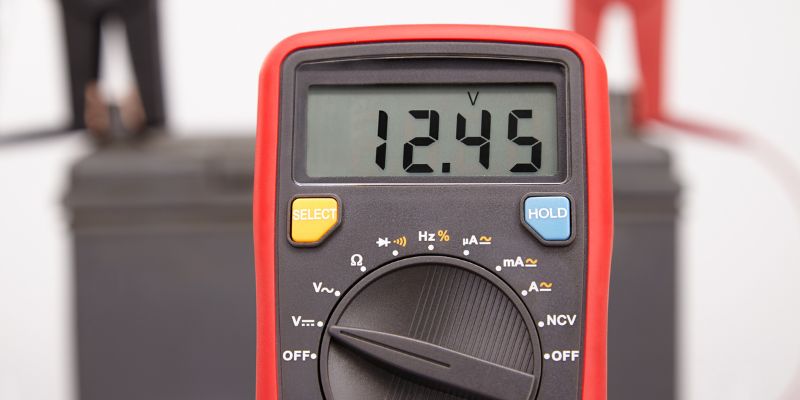What will you do when a battery failure in your forklift or other material handling equipment brings your operations to a grinding halt?
You know how expensive and disruptive battery problems are – from downtime to in-lease replacement.
So, it helps to know how to prevent common battery problems.
After selecting quality batteries and following recommended maintenance schedules, battery testing is the next critical step.
In this guide, you'll discover the basics, including:
- 5 ways battery testing benefits you
- How batteries differ and what that means for measuring
- Which tools make testing easier, faster, and more accurate
- Simple checks that detect problems early – to improve safety, uptime, and profitability
- 7 battery-testing mistakes you must avoid
5 Ways Battery Testing Benefits You:
- Identifies minor issues before they become big problems, making cost-effective, targeted maintenance and repairs possible – and preventing costly downtime.
- Prevents common causes of accidents and fires: Failing or overloaded batteries pose safety risks, especially if lithium-ion batteries experience thermal runaway – “uncontrolled self-heating” that can cause fires and explosions.
- Boosts uptime: Unplanned battery replacement can mean lead times that stretch into days or weeks – especially during supply chain shortages. And without a battery, you can’t operate a truck. In contrast, when batteries have a clean bill of health, they’re far more reliable – and so are your operations.
- Improves operational efficiency: Batteries in poor condition slow down operations, lower worker productivity, and increase hours required to complete work. Meanwhile, proper testing ensures efficient operations.
- Saves money because you don’t have to replace batteries on lease trucks. (Bonus: Your forecasting improves.)
Different batteries = different benefits, different testing needs
Flooded Lead-Acid (FLA) Batteries
FLA batteries command the majority of the Material Handling market due to their reliability, safety, and low upfront and lifetime costs. They’re also more recycled than an aluminum can (source: US Environmental Protection Agency – see more details here).
Lead-acid batteries require routine testing and watering to ensure peak performance and longevity. Regular testing also helps reveal issues like sulfation or declining capacity so you can take corrective action early.
Absorbent Glass Mat (AGM)
AGM batteries offer high reliability and recyclability, like lead-acid batteries. In addition, their near-zero maintenance design improves vibration resistance and high-current delivery. While their upfront cost is higher than lead-acid models, reduced labor for maintenance often more than offsets this difference.
Testing is similar to lead-acid batteries, except AGM models never need to be watered because they are sealed.
Lithium-ion (LI) Batteries
LI batteries are also near-zero maintenance and feature a higher energy density, making them lighter and smaller. They’re often 3X more than lead-acid for the same Ampere-hour (Ah) throughput over a battery’s lifetime. Today, only 5% of lithium-ion batteries are collected for recycling (source: Chemical & Engineering News’s “It’s time to get serious about recycling lithium-ion batteries”).
Lithium-ion models require additional attention because their higher energy density makes them more susceptible to thermal runaway. (See the UL Research Institutes’ “ What is Thermal Runaway?” for more information.)
These simple tests detect battery problems early
Visual Inspection
Look for:
- Physical case damage, like cracks or bulges
- Electrolyte leakage or corrosion (including terminals)
- Wire and connector nicking or burn marks
- Overheating, especially smoking
Voltage Testing
Voltage Testing is a straightforward way to gauge a battery's health and best performs with a multimeter.
Multimeters measure basic electric measurements like voltage, current, and resistance. Look for a model with auto-ranging capabilities, high accuracy, insulated probes, and a ruggedized case for durability.
A standard test involves measuring the voltage output when the battery is not under a load. Then, compare the reading to the battery's rated voltage to check for discrepancies.
Your manufacturer should provide detailed, simple instructions for voltage testing.
Here are some guidelines:
For Lead-Acid and AGM Batteries
Ensure batteries have no loads for at least four hours beforehand for accurate readings. (If that’s not possible, your manufacturer’s manual should explain how to perform a 50% State of Charge test.) A reading below the recommended range could signify a problem. (Note: New batteries might require a "break-in" period before providing optimal voltage levels.)
For Lithium-Ion Batteries
Lithium-ion batteries typically operate at higher voltages. Lower readings can indicate undercharging, ultimately leading to deep discharge, severely impacting the battery's lifespan and performance. Again, refer to your manufacturer's manual for specific instructions.
Load Testing
To help troubleshoot batteries and identify internal defects, a load tester applies a specific electrical load to the battery and measures the battery’s response. When selecting a load tester, consider features like easy-to-read displays, accuracy, durability, and built-in safety mechanisms like circuit protection. (Note that Crown Battery does not approve load testing for determining deep-cycle battery capacity.)
Specific Gravity (SG) Measurement
For FLA batteries, a hydrometer measures the SG of the electrolyte – and can tell you about the charge state and health of the battery. The higher the SG of the electrolyte, the higher the charge. Choose a hydrometer that is easy to read, accurate, and has safety features to prevent spillage and contamination. Calibrate your hydrometer following manufacturer guidelines.
7 Common Testing Mistakes to Avoid
Mistake #1: Using Outdated or Incorrect Tools.
This may provide inaccurate readings – and lead to wrong diagnoses. Select proper tools, calibrate them regularly, and always follow manufacturers’ calibration guidelines.
Mistake #2: Testing Under Unsuitable Environmental Conditions.
Temperature, humidity, and even altitude can affect battery performance and testing accuracy. The optimal battery testing temperature is typically around 25°C (77°F). Follow manufacturer guidelines to avoid false readings. And consider recording ambient and battery temperature as well.
Mistake #3: Not Keeping Good Records.
If records are missing, inaccurate, or inconsistent, tracking performance trends or effectively troubleshooting issues is difficult. Always keep a detailed log of all tests performed, readings/results obtained, dates, who performed the tests, and any actions taken.
Mistake #4: Picking an Inconvenient Testing Location.
This wastes time and can lead to errors, including forgetting steps or misplacing tools. The best place to keep everything is near the battery charging area. Create a dedicated space for your logbook (or internet-connected device to access a digital logbook), testing equipment, and personal protective equipment (PPE). Doing so makes maintaining a consistent testing routine easier and more time-efficient.
Mistake #5: Inconsistent Testing Schedules.
It can result in problems going undetected until it’s too late. But how often should you test batteries – and what are the right tests for your situation?
Your battery manufacturer or energy storage consultant can help customize your testing plan based on your exact operational needs, including:
- Battery Chemistry
- Level of discharge
- Charging method (conventional, fast charging, opportunity charging)
- Operating conditions such as temperature
Once you determine your optimal testing plan and schedule, print out visual reminders and make it part of your workflow or scheduling software.
Mistake #6: Ignoring Safety Protocols and Gear.
Ignoring safety protocols/gear can put your people in danger. To keep employees safe:
- Select safety goggles, gloves, protective clothing, and other PPE specifically designed for electrical work.
- Ensure employees always wear PPE.
- Require employees to always remove jewelry, electronics, and metallic objects before testing batteries.
- Follow all manufacturer recommendations.
- Post a visual checklist of necessary safety gear near testing stations. For text-based safety instructions, consider displaying multilingual posters in employees’ native languages.
Mistake #7: Not getting your complimentary, no-B.S. “Safety.First.” battery guide.
Now that you know the basics of battery testing, you’re ready to go deeper with our easy-to-follow, gratis guide to safe battery maintenance and testing. Click the button below to select the guide right for you.











